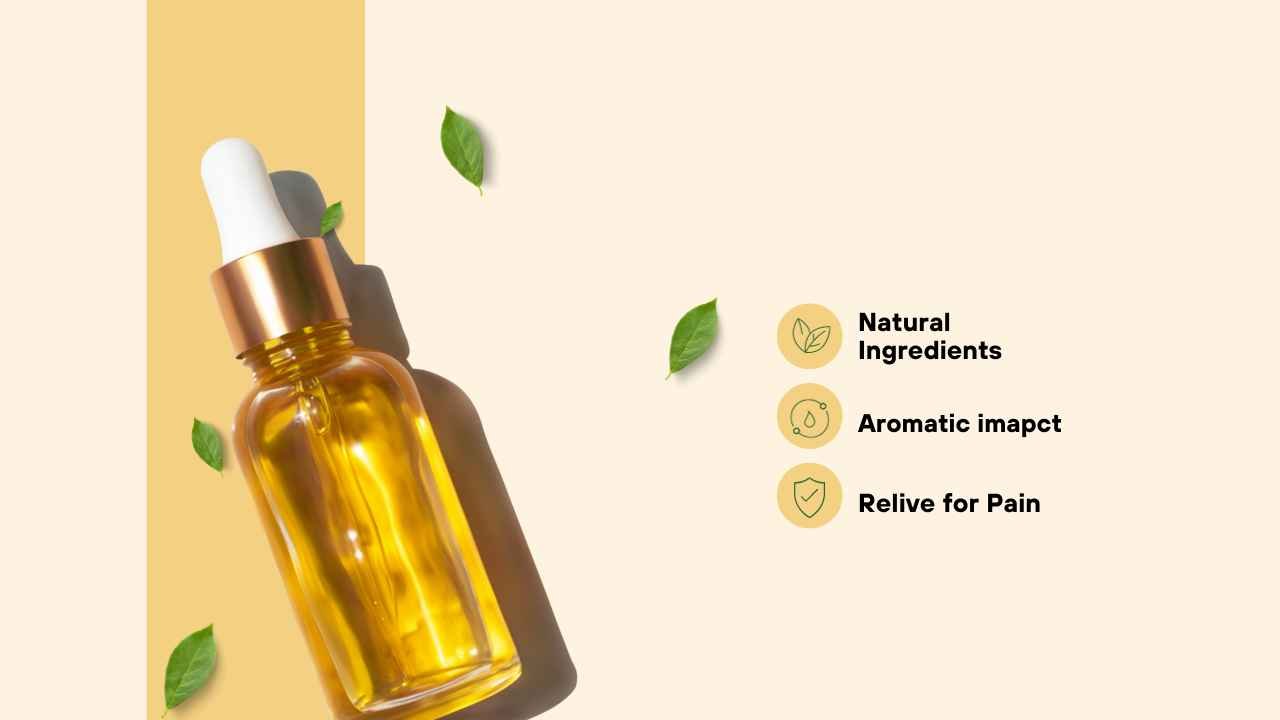Because of the many therapeutic advantages of essential oils like the possibility that they might reduce pain, they are gaining a lot of appeal. Intensity and origin of pain, which is a human experience that is shared by all people can vary.
Discomfort is something that many want relief from and it may range from headaches to chronic diseases. In recent years, there has been a growing desire among those who are looking for alternate methods of pain management to investigate the Strongest essential oil for pain.
Essential oils, which are made from plant materials include chemicals that are highly concentrated and successfully capture the essence and scent of the plants. They are often used in aromatherapy and other wellness activities due to the fact that they are known for their fragrant characteristics and therapeutic impacts. There are a variety of properties that these oils offer that may be helpful in controlling the sensation of pain.
Criteria for strongest essential oil for pain
An essential oil’s strength is dependent on its chemical make-up, concentration and degree of purity, among other things. An oil’s ability to alleviate pain is highly dependent on its potency.
List of The Strongest Essential Oil for Pain
Some strongest essential oil for pain stand out among the many available for their strong pain-relieving properties. When it comes to relieving various forms of pain, some of the most powerful oils.
Lavender: Known for its calming and soothing properties, lavender oil is popular for relaxation, stress relief, and promoting better sleep.
Rose: Rose essential oil is valued for its floral aroma and is often used in aromatherapy for its mood-enhancing and stress-relieving properties.
Bergamot: This citrus oil is known for its refreshing scent and is used to uplift moods, reduce stress, and support relaxation.
Nutmeg: This is one of the most effective oils for inflammation and pain. useful for joint muscle pain , chronic conditions like arthritis and rheumatism etc.

Wintergreen: Wintergreen oil contains methyl salicylate, providing a cooling sensation. It’s used topically for muscle and joint discomfort.
Peppermint: Renowned for its cooling effect, peppermint oil is used to alleviate headaches, muscle tension, and digestive issues.
Rosemary: Rosemary oil is recognized for its stimulating aroma and is used to aid concentration, relieve muscle aches, and promote scalp health.
Eucalyptus: Eucalyptus oil is valued for its respiratory benefits and is used to ease congestion, as well as for its anti-inflammatory properties for joint and muscle pain relief.

Chamomile: Chamomile oil, particularly Roman chamomile, is known for its calming effects and is used to reduce stress, promote relaxation, and soothe skin irritations.
Clary Sage: Clary sage oil is known for hormonal balancing properties and is used for menstrual discomfort, stress relief, and promoting relaxation.
Ginger: Ginger oil is popular for its warming properties and is used to ease digestive issues, muscle discomfort, and to support circulation.
Clove: Clove oil is known for its antiseptic and analgesic properties and is used for dental care, as well as to soothe toothaches and muscle pain.
Lemongrass: Lemongrass oil has a fresh, citrusy scent and is used for its uplifting aroma and as an insect repellent.

Frankincense: Valued for its earthy and resinous aroma, frankincense oil is used in meditation practices and for its calming, grounding effects.
Each of these oils has unique benefits and applications, but it’s crucial to use them appropriately and safely.
Safely Precautions for using
Dilution: Strongest essential oil for pain are highly concentrated and should be diluted with a carrier oil (such as coconut oil or almond oil) before applying to the skin. A typical dilution ratio is around 2-5 drops of essential oil per teaspoon of carrier oil.
Patch Testing: Before using any essential oil, perform a patch test on a small area of your skin to check for any allergic reactions or skin sensitivities. Apply a diluted amount of the essential oil and observe for any adverse reactions for at least 24 hours.
Consultation: If you have any known allergies, sensitivities, or underlying health conditions, it’s advisable to consult with a healthcare professional or an aromatherapist before using essential oils for pain relief.
Proper Application: The strongest essential oil for pain should never be ingested unless under the guidance of a qualified healthcare practitioner. When applying topically, avoid sensitive areas such as the eyes, mucous membranes, and broken or irritated skin.
Storage: Store essential oils in dark glass bottles in a cool, dry place away from direct sunlight. This helps maintain their potency and extends their shelf life.
Pregnancy and Children: Exercise extra caution during pregnancy or when using essential oils on children. Certain oils may not be safe for use during pregnancy or for young children, so it’s essential to seek advice from a healthcare professional.
Start Slowly: Begin with a low concentration of essential oil and gradually increase if needed. Pay attention to your body’s response and discontinue use if you experience any adverse effects.
How strongest essential oil for pain Relief work?
Strongest essential oil for pain relief through their various properties, including analgesic (pain-relieving) and anti-inflammatory effects. These oils interact with the body’s receptors, providing relief for a wide range of pains, such as headaches, muscle tension, and joint discomfort.
Analgesic Properties: Many essential oils contain compounds that exhibit analgesic properties. These components interact with the body’s sensory receptors, potentially reducing the perception of pain.
For instance, oils like lavender, peppermint, and eucalyptus are known for their analgesic effects, which can help alleviate headaches and muscular discomfort.
Anti-inflammatory Effects: Inflammation often accompanies pain, especially in conditions like arthritis or injuries. Certain essential oils possess anti-inflammatory properties that can help reduce swelling and inflammation in affected areas.
Oils such as chamomile, ginger, and frankincense contain compounds that may mitigate inflammation, providing relief from joint pain and stiffness.
Receptor Interaction: The strongest essential oil for pain can interact with receptors located throughout the body, including those in the skin, muscles, and nervous system. When applied topically or inhaled through aromatherapy, these oils stimulate these receptors, potentially modulating pain signals and promoting a sense of relief.
Aromatherapy’s Impact on Emotions: Beyond their physical effects, essential oils used in aromatherapy can positively influence emotions and mental well-being. Certain oils have calming or mood-enhancing properties that help alleviate stress, which can indirectly reduce the perception of pain.
Support for Traditional Medicine: While essential oils can provide relief, they often complement traditional medical approaches rather than replace them. They may be used in conjunction with other pain management strategies to enhance overall well-being and improve the effectiveness of treatment plans.
Personal Testimonials and Experiences
Many individuals have shared their personal testimonials and experiences regarding the use of strongest essential oil for pain management. These real-life accounts highlight the positive impact these oils can have on improving one’s quality of life.
Relief from Chronic Pain: Some people suffering from chronic pain conditions, such as arthritis or fibromyalgia, have reported significant relief after using certain essential oils. They often describe reduced pain levels and improved mobility, allowing them to engage in daily activities more comfortably.
Headache and Migraine Relief: Individuals dealing with frequent headaches or migraines often find relief by using essential oils like peppermint or lavender. They share how these oils, when applied topically or through inhalation, can alleviate the intensity and duration of their headaches, providing a sense of relief and relaxation.
Muscle Aches and Pains: Athletes or individuals experiencing muscle soreness have shared their positive experiences using strongest essential oil for pain like eucalyptus or rosemary. They describe the soothing effect these oils have when applied in massage or added to baths, easing muscle tension and discomfort.
Reduced Nerve Pain: Some individuals dealing with nerve-related pain, such as neuropathy, have found essential oils like frankincense or chamomile helpful in managing their symptoms. They mention a decrease in nerve pain intensity and improved sensations in affected areas.
Emotional Well-being: Beyond physical pain relief, many people report the mood-lifting and stress-reducing benefits of essential oils like citrus oils (such as bergamot or lemon) or floral oils (like ylang-ylang or geranium). These oils are often used in aromatherapy, promoting relaxation and a sense of calmness, which can indirectly alleviate stress-related pain.
While these testimonials reflect positive experiences, it’s essential to recognize that individual responses to essential oils can vary. What works well for one person may not have the same effect on another.
Conclusion
Understanding the strongest essential oil for pain is essential. With proper knowledge, usage and caution so these natural remedies can offer significant relief from various types of discomfort.
FAQs
1:What are the precautions for using essential oils during pregnancy?
Pregnant women should use essential oils cautiously. Some oils are considered safe during pregnancy, while others should be avoided entirely. Oils like chamomile, lavender, and citrus oils are generally considered safe in limited amounts, while oils like clary sage and rosemary should be avoided during pregnancy due to their potential effects on hormones or contractions. Consultation with a healthcare professional is strongly advised before using essential oils during pregnancy.
2.Can essential oils interact with medications?
Yes, essential oils can interact with certain medications. Some oils may affect the absorption, metabolism, or effectiveness of medications, leading to potential interactions or side effects. It’s crucial to consult a healthcare professional, especially if you are taking medications, to avoid any adverse interactions between essential oils and prescribed drugs.


2 Comments